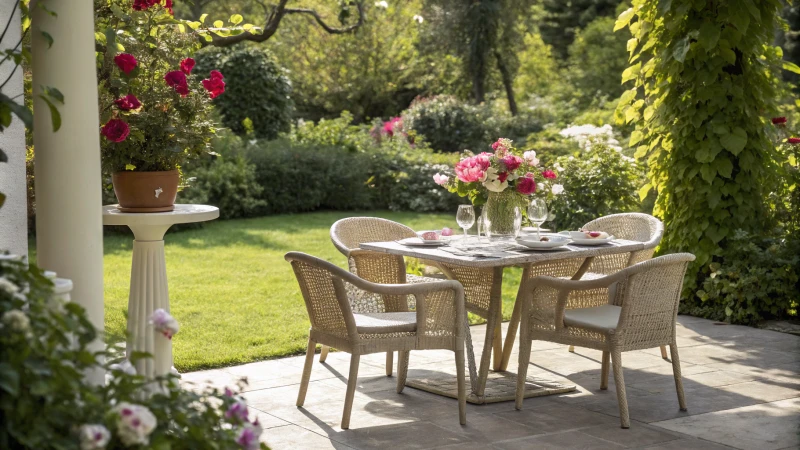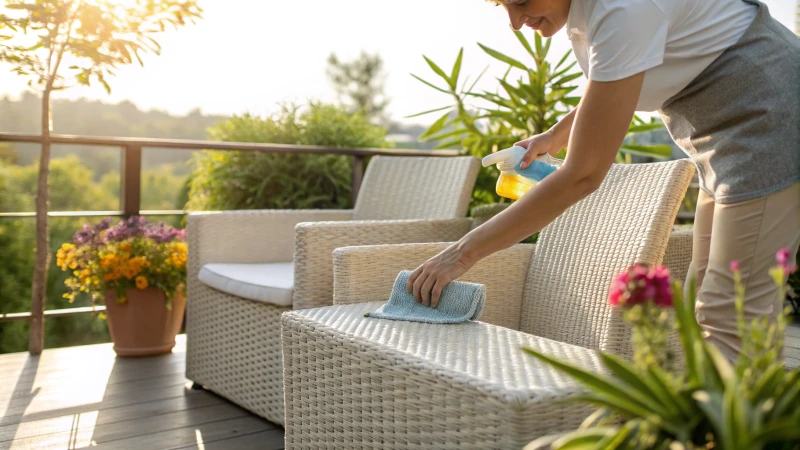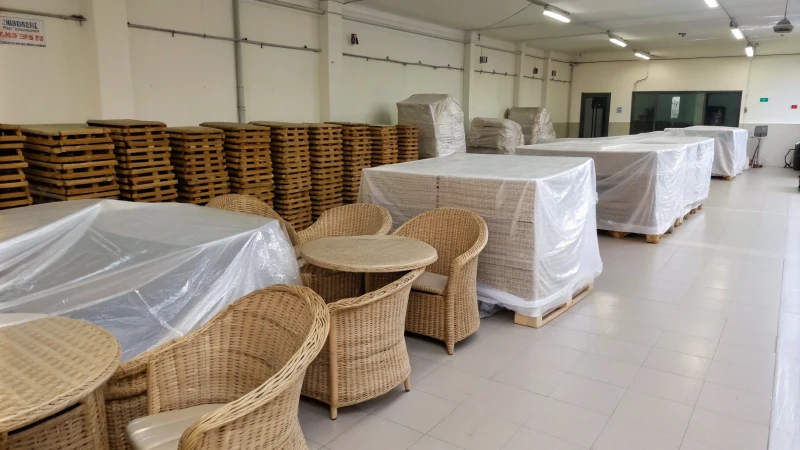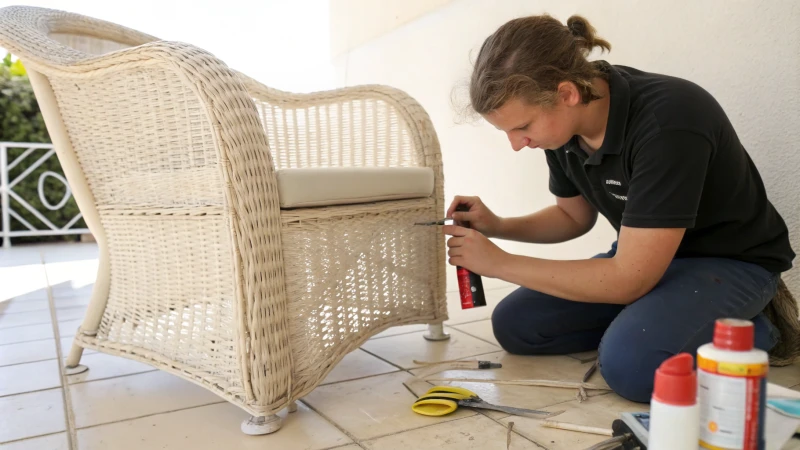
Is your outdoor dining set looking old and worn out? I turned mine from dull to beautiful. You probably can too!
Regularly clean the plastic wicker of your outdoor dining set with mild soap and water. Avoid using harsh chemicals. Apply a UV protectant to stop fading. This step keeps your furniture beautiful. Your furniture stays beautiful. It lasts a long time.
I remember the first summer after buying my outdoor dining set. It was the perfect place for brunches and late-night talks under the stars. The seasons changed and I noticed the wicker losing its color and getting dirty. A simple mix of mild soap and water really cleaned it well. Harsh chemicals might damage it, so I avoid those. Now, I regularly use a UV protectant. This small routine really helps!
Regular cleaning prevents damage to plastic wicker furniture.True
Cleaning your outdoor dining set regularly helps maintain its appearance and durability by removing dirt and grime that can cause wear.
Harsh chemicals improve the lifespan of plastic wicker.False
Using harsh chemicals can actually damage plastic wicker, reducing its lifespan and causing discoloration.
What Cleaning Products Are Safe for Plastic Wicker?
Are you ready to take care of your plastic wicker furniture? Let’s explore easy and safe cleaning tips. These tips help keep your beloved furniture looking fresh and bright.
Choose mild dish soap, vinegar solutions or baking soda paste to clean plastic wicker furniture safely. These gentle options protect the material. Bleach and abrasive cleaners harm the surface and should be avoided. Using gentle methods preserves the furniture’s integrity.

Understanding Plastic Wicker Materials
Plastic wicker is a popular choice for outdoor and indoor furniture due to its durability and resistance to weathering. Commonly made from high-density polyethylene (HDPE), it mimics the appearance of natural wicker while offering enhanced longevity.
When cleaning plastic wicker, it’s essential to use products that won’t cause fading or deterioration. Here are some safe cleaning products:
- Mild Dish Soap: A mixture of warm water and mild dish soap is often sufficient for routine cleaning. This solution is gentle and effective against dirt and grime.
- Vinegar Solution: For tougher stains, mix equal parts of white vinegar and water. Vinegar acts as a natural disinfectant without harsh chemicals. Learn more about eco-friendly cleaning solutions1.
- Baking Soda Paste: If you encounter stubborn stains, create a paste with baking soda and water. Apply it to the stain, let it sit, then scrub gently before rinsing.
Recommended Cleaning Techniques
To maintain your plastic wicker furniture, here are some techniques to consider:
| Technique | Description | Best For |
|---|---|---|
| Wiping | Use a soft cloth dampened with the soap solution | Regular maintenance |
| Scrubbing | Use a soft-bristled brush for embedded dirt | Stubborn stains |
| Rinsing | Rinse with clean water to remove any soap residue | After every cleaning |
Avoiding Harmful Chemicals
Certain cleaning products can damage plastic wicker, leading to discoloration or brittleness. Avoid:
- Bleach: This can weaken the material and cause fading.
- Abrasive Cleaners: Powders or scrubbing pads can scratch the surface.
- Solvent-Based Cleaners: These may dissolve the plastic over time.
Instead, focus on gentle alternatives that effectively clean without causing harm. Explore safe cleaning practices2.
Importance of Regular Maintenance
Regular cleaning not only keeps your furniture looking great but also extends its lifespan. Establish a routine cleaning schedule based on usage and environmental exposure. Seasonal deep cleans can help prevent buildup of dirt and mildew, especially for outdoor items.
Using safe products ensures that your plastic wicker remains vibrant and functional for years. Incorporate these methods into your care routine for optimal results. Find out more about seasonal maintenance3.
Mild dish soap is safe for cleaning plastic wicker.True
Using a mixture of warm water and mild dish soap effectively cleans plastic wicker without causing damage or fading.
Bleach can be used on plastic wicker without harm.False
Bleach can weaken plastic wicker, leading to discoloration and brittleness, so it should be avoided.
How Often Should I Clean My Outdoor Wicker Furniture?
Wonder how frequently you need to clean your outdoor wicker furniture? I understand! Keeping it fresh and long-lasting is important. Regular care is key to its longevity and appearance.
Clean your outdoor wicker furniture every 2-4 weeks. Weather and how often you use it probably change this schedule. Simple upkeep stops damage and really extends its life. Regular cleaning is essential.

Understanding Wicker Furniture Care
Outdoor wicker furniture is an elegant addition to any patio or garden. However, its longevity depends significantly on how often it is cleaned and maintained.
For general upkeep, it is advisable to clean your wicker furniture every 2-4 weeks, depending on environmental conditions. Dust, pollen, and debris can accumulate quickly, especially in outdoor settings.
Factors Influencing Cleaning Frequency
Several factors can influence how often you should clean your wicker furniture:
| Factor | Cleaning Frequency |
|---|---|
| Location (coastal) | Every 2 weeks |
| Exposure to elements | Weekly |
| Type of use | After heavy use |
| Seasonal changes | Every month |
Regular cleaning not only keeps the furniture looking pristine but also helps to prevent long-term damage from mold and mildew, which can thrive in damp conditions.
Seasonal Maintenance Tips
During different seasons, the frequency of cleaning may vary:
- Spring: Start the season with a thorough cleaning to remove dust and pollen.
- Summer: Clean every two weeks, particularly if you frequently use the furniture.
- Fall: As leaves fall, clean more often to avoid buildup.
- Winter: Store indoors if possible; otherwise, a monthly clean is sufficient.
By adhering to a seasonal maintenance schedule, you can ensure that your wicker furniture remains in top condition throughout the year. For more detailed care tips, check out this link: care tips for outdoor wicker4.
How to Clean Wicker Furniture
Cleaning wicker furniture requires a gentle touch:
- Dusting: Use a soft brush or cloth to remove dust and debris.
- Soaping: Mix mild soap with warm water and wipe down surfaces with a soft cloth.
- Rinsing: Rinse with clean water using a damp cloth to remove soap residue.
- Drying: Allow the furniture to air dry completely to prevent moisture damage.
Protective Measures
Consider applying a protective coating designed for wicker furniture to enhance durability and protect against UV damage. For additional insights on protective products, visit wicker protection solutions5.
Maintaining your outdoor wicker furniture doesn’t have to be a daunting task. By establishing a regular cleaning routine and understanding the unique needs of your pieces, you can enjoy their beauty for many years to come.
Outdoor wicker furniture should be cleaned every 2-4 weeks.True
Regular cleaning every 2-4 weeks helps maintain the appearance and longevity of outdoor wicker furniture, adapting to environmental conditions.
Wicker furniture requires weekly cleaning in coastal areas.True
Due to increased exposure to elements, wicker furniture in coastal areas should be cleaned weekly to prevent damage and accumulation of debris.
What Are the Best Practices for Storing Wicker During Off-Season?
Storing wicker furniture during the off-season involves more than just protection. It’s about caring for memories and investments. I will explain some important steps to keep your wicker pieces beautiful. These tips help maintain beauty for many years.
To keep wicker furniture beautiful during the off-season, clean it well. Put items in a dry area. Use protective covers on furniture. Often look for moisture or pest damage. Maybe do it regularly.

Understand the Importance of Proper Storage
Storing wicker furniture properly during the off-season is essential to prolong its life. Wicker items, made from natural materials like rattan or willow, can be vulnerable to moisture, cold temperatures, and UV rays.
Failing to store them correctly can lead to mold growth, fading colors, and even structural damage. Consider a few key factors:
- Humidity Levels: High humidity can cause wicker to absorb moisture, leading to mold.
- Temperature Fluctuations: Extreme cold can make wicker brittle.
Cleaning Your Wicker Before Storage
Before you store your wicker furniture, it’s crucial to clean it properly. Here’s a quick checklist for cleaning:
| Step | Description |
|---|---|
| Dust and Debris Removal | Use a soft brush or cloth to remove dust. |
| Mild Soap Solution | Clean with a solution of mild soap and water. |
| Dry Thoroughly | Ensure the wicker is completely dry before storage. |
Ideal Storage Conditions
When it comes to storing wicker furniture, conditions matter. Here are some best practices:
- Choose a Dry Location: Store wicker in a dry, well-ventilated area away from direct sunlight.
- Use Protective Covers: Consider investing in breathable covers to protect against dust and pests while allowing air circulation.
- Elevate from the Ground: Place wicker items on pallets or shelves to avoid direct contact with the ground, reducing moisture absorption.
Additional Protective Measures
In addition to storage location and cleaning, consider these protective measures:
- Use a Sealant: Apply a protective sealant designed for wicker to help resist moisture.
- Temperature Control: If possible, store in an area with controlled temperature, ideally between 10°C and 20°C (50°F and 68°F).
- Check Regularly: Periodically check stored items for signs of moisture or pests.
For further insights into maintaining your wicker products, visit wicker care tips6 or explore seasonal storage solutions.
Wicker furniture should be stored in a dry location.True
Storing wicker in a dry area prevents moisture absorption, which can lead to mold growth and damage.
Using plastic covers is ideal for storing wicker furniture.False
Plastic covers trap moisture, risking mold; breathable covers are preferred for air circulation.
How Can You Repair Minor Damage to Plastic Wicker?
Ever looked at your favorite plastic wicker chair and seen a small tear or crack? It feels really disappointing. But don’t worry! Fixing small damage is easier than you probably think.
To fix small damage on plastic wicker, first look closely at the problem. Gather items like clear glue and scissors. Then, follow simple steps to fix your furniture. It’s really not hard!

Fixing Small Damage to Plastic Wicker
Fixing small damage to plastic wicker is like solving a favorite puzzle. The first time I tried, it felt really daunting. Although it seemed hard at first, I restored my furniture with a few tools and patience. You could probably do it too!
Understanding Plastic Wicker
Plastic wicker is a popular choice for outdoor furniture due to its durability and weather resistance. However, even the sturdiest materials can suffer from minor damages over time, like fraying or cracking.
To effectively repair plastic wicker, it’s essential to identify the type of damage you’re facing. Here are some common issues:
- Fraying Strands: This often occurs from sun exposure or wear and tear.
- Cracks: These can develop from impacts or extreme temperatures.
- Broken Sections: Entire pieces may come loose, requiring replacement.
Tools and Materials Needed
Before diving into the repair process, gather the following tools and materials:
| Tool/Material | Purpose |
|---|---|
| Clear Epoxy Adhesive | For gluing broken pieces back together |
| Scissors | To trim frayed ends |
| Replacement Strands | For re-weaving damaged sections |
| Heat Gun | To soften plastic for reshaping |
| Sandpaper | To smooth out rough edges |
These materials will help ensure a successful repair, preserving both functionality and aesthetics.
Step-by-Step Repair Process
Here’s a simple guide on how to tackle each type of damage:
-
Repairing Frayed Strands:
- Trim any frayed ends using scissors.
- Use clear epoxy adhesive to secure the cut strands in place.
-
Fixing Cracks:
- Clean the crack area with a damp cloth.
- Apply a thin layer of clear epoxy adhesive, ensuring it fills the crack completely.
- Allow it to dry as per the product instructions.
-
Replacing Broken Sections:
- Remove the damaged section carefully.
- Measure and cut a replacement strand from a similar material.
- Weave the new strand into the wicker pattern, securing it with adhesive if necessary.
Maintenance Tips
To extend the life of your plastic wicker furniture, consider these maintenance tips:
- Regularly clean your furniture with a mild soap solution to prevent dirt buildup.
- Store your items indoors during harsh weather conditions to avoid extreme damage.
- Inspect your furniture periodically for early signs of wear, allowing for timely repairs before problems worsen.
For additional information on maintaining wicker furniture, check out our complete guide on wicker care7.
Plastic wicker is weather-resistant and durable.True
Plastic wicker is designed to withstand outdoor conditions, making it a durable choice for furniture. Its weather resistance helps prevent damage from sun and rain.
Fraying strands can be repaired with clear epoxy adhesive.True
Using clear epoxy adhesive effectively secures frayed strands, restoring the integrity of plastic wicker furniture and enhancing its appearance.
Conclusion
Learn effective tips for maintaining and repairing your outdoor plastic wicker furniture to ensure its longevity and beauty through regular cleaning and safe repair techniques.
-
This link provides valuable insights on eco-friendly cleaning options that are effective yet gentle on plastic wicker. ↩
-
Explore this resource for safe cleaning practices tailored to different materials, ensuring your wicker stays in top shape. ↩
-
Learn about seasonal maintenance tips that will help extend the life of your outdoor furniture, including plastic wicker. ↩
-
Discover practical cleaning schedules and tips to maintain your wicker furniture’s appearance and longevity throughout the year. ↩
-
Learn about specific cleaning products and techniques that can extend the life of your outdoor wicker furniture. ↩
-
Clicking this link will provide you with expert tips on maintaining your wicker furniture throughout different seasons, ensuring durability and beauty. ↩
-
Discover effective DIY methods for repairing plastic wicker, ensuring longevity and beauty in your furniture. ↩

